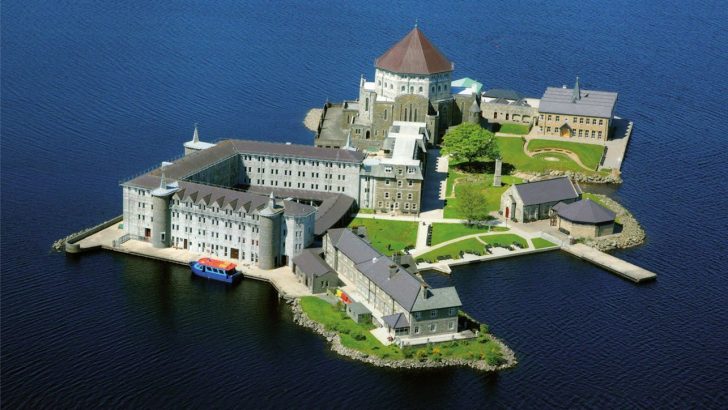Greg Daly
experiences Lough Derg for himself
Back in 1841 one Caesar Otway, a traveller in Mayo, wrote in scorn of a lake in the area, saying it compared to his mind with Donegal’s Lough Derg, a place, he said, “where superstition disgraces what nature has made but ugly”.
It’s hard to imagine a more unfair comment in respect either of the lake’s beauty or the value of the three-day pilgrimage for which its Station Island is famous, and perhaps if the aforementioned Anglican had tried the latter he might have taken a very different line.
Though curious, I was a somewhat reluctant pilgrim to the island, having agreed to do the pilgrimage last year only after two of my colleagues here at The Irish Catholic came back from Lough Derg invigorated and bubbling over with stories of their experience. Since then it loomed ever nearer in my calendar, with my ambivalence about the pilgrimage not fading as the date drew closer. That in the end it was set to fall immediately after a week’s holidays seemed a rather cruel joke; yes, of course I’d be enjoying myself in my time off, but did that really merit such a penance?
Tickets
Getting to the island by public transport couldn’t have been simpler, Bus Eireann taking me from Dublin to Enniskillen where I and other pilgrims from around the country boarded a shuttle bus to the lakeshore, there to collect tickets and a leaflet before stepping onto the fast ferry over to the island.
It wasn’t long before I was settled there, my bag on my dorm bed and my shoes under it, as I headed barefoot towards the penitential beds to get a look at what the island really involved. Astounded at how many pilgrims were already doing circuits of them, I went into the basilica with my leaflet to make a start on my first station.
I’d be lying if I said I didn’t find that first station as contrived as I did difficult: kneeling, standing, walking, with one prayer here, three prayers there all adding up to 94 Our Fathers, 157 Hail Marys, 27 Apostles’ Creeds, and one psalm, all barefoot and especially on the first two penitential beds on ground that was far from easy to walk on, even in fine, dry conditions – it all felt like a devotional obstacle course, and one that didn’t seem to make a lot of sense.
That said, over the last few years one thing I’ve learned to do is to trust processes, and with 1,500 years of history behind it, there’s clearly something special about the Lough Derg exercises, so as I tried to balance when kneeling on irregular rocks, quite literally clinging to the Cross to stay upright, I embraced the devotions. They’d make sense eventually. They did.
The second and third exercises were slower, more solitary, in a sense easier, even if I was plagued by midges, and the four stations conducted within the basilica through the night posed other challenges again – exhaustion and hunger meant that these exercises took on a trance-like quality.
Between exercises there was a startling warmth and camaraderie, with pilgrims gathered in the Flood Room next door to chat, support each other, tell stories of the island and their lives, and gain some manner of sustenance from cups of hot water, often flavoured with sprinklings of salt and pepper. Pilgrimages are so often imagined as dour and puritanical things, but only by those who’ve never been on one or even thought of how Chaucer’s Canterbury Tales was inspired by the banter and storytelling of pilgrims making their way to the tomb of St Thomas Becket.
Morning came, and with it Mass, where exhausted heads struggled to stay upright, and then a Reconciliation service and Confession, transformative for so many over the years, before I began my eighth station. Circling the basilica as I said decade after decade of the Rosary I called to mind so many people – friends, family, the newly born and the long dead, those I’ve wronged and those who’ve wronged me, deliberately recalling them as best I could before tackling the penitential beds.
Fatigue
It took all I had to manage the prayers at this point, fatigue mingling words and setting them to unexpected and unlikely rhythms, but eventually I finished my station and spent the rest of the day, the Way of the Cross aside, listening to other pilgrims tell me why the island matters to them so much.
Sleep couldn’t have been more welcome that night, with a horde of pilgrims sighing with gratitude as the vigil candle was extinguished and they raced off to bed.
And so on the third day on the island we rose again, and as we joined in the Mass delighted and alert, it began to be obvious why the Apostles’ Creed seems so right for the island’s exercises: in its line “he descended into Hell” it hammers home the reality of Easter and the time between Our Lord’s suffering and his resurrection. The final station was almost impossibly beautiful, as this time I didn’t even need to think of who I wanted to pray for as face after face appeared in my mind, not as a pell-mell confused rush, but serenely, one by one, prayer after prayer, unbidden and unrepeated.
When I left the island I was smiling like everyone else, and as I’d been told, it was less with relief than with gratitude. Will I be back? I’m not saying no.


 Greg Daly
Greg Daly